
Film
Browse an alphabetical list of film clips that feature important events before, during, and after the Holocaust and World War II. These clips include home movies, propaganda films, newsreels, and more.
<< Previous | Displaying results 1-50 of 191 for "Film" | Next >>
-
100-meter race at the Olympic Games in Berlin, 1936
Film[This video is silent] Olympic athlete Jesse Owens won four medals at the 1936 Olympic Games in Berlin, Germany: 100-meter dash, gold200-meter dash, goldBroad (long) jump, gold4x100-meter relay, gold This footage shows Owens winning the 100-meter dash in a time of 10.3 seconds. Owens was one of the 18 African Americans (16 men and 2 women) who competed in the 1936 Olympic Games in Berlin. These athletes brought home 14 medals: 8 gold; 4 silver; and 2 bronze.

-
Adam Czerniakow, chairman of the Jewish council in Warsaw
Film[This video is silent] German forces entered Warsaw in September 1939. The next month, they ordered the establishment of a Jewish council (Judenrat) in the city. They chose Adam Czerniakow, a member of Warsaw's old Jewish Community Council, to lead it. Here, for German newsreels, a German propaganda company stages a meeting between Czerniakow and petitioners from the ghetto. The Germans expected Czerniakow to implement German orders, including demands for forced labor and confiscations of Jewish-owned…
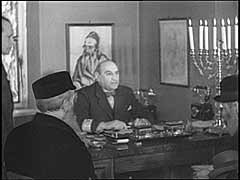
-
Aerial view of Dachau concentration camp
Film[This video is silent] The Dachau concentration camp, northwest of Munich, Germany, was the first regular concentration camp the Nazis established in 1933. About twelve years later, on April 29, 1945, US armed forces liberated the camp. There were some 30,000 starving prisoners in the camp at the time. This footage shows an aerial view of the camp and the entrance gate to the prisoner compound.
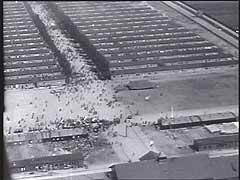
-
Aftermath of battle in Danzig
FilmThe Treaty of Versailles, imposed on Germany following its defeat in World War I, declared Danzig to be a free city jointly administered by Poland and the League of Nations. Germany bitterly resented the loss of this largely German city, which was also an important port on the Baltic Sea. The return of Danzig to Germany became a central focus of Adolf Hitler's foreign policy. Germany invaded Poland in September 1939. After the invasion of Poland, Germany unilaterally annexed Danzig. This German newsreel…
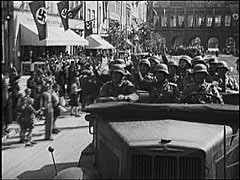
-
Aftermath of pogrom in Kielce
FilmA pogrom took place in Kielce, Poland, in July 1946. Forty-two Jews were massacred and about 50 more were wounded. The event touched off a mass migration of hundreds of thousands of Jews from Poland and other countries of eastern and central Europe. This clip shows Jewish refugees, survivors of the pogrom, waiting to leave Poland and crossing into Czechoslovakia.
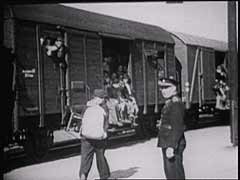
-
Aftermath of the liberation of a forced-labor camp in Germany
Film[This video is silent] There were three large forced-labor camps in Hannover, a large industrial city in northern Germany. All three of the camps were part of the Neuengamme concentration camp system. In early April 1945, American forces entered Hannover and freed the surviving prisoners. The American Signal Corps filmed one of the Hannover camps soon after liberation. American forces fed survivors of the camp and required German civilians to help bury the dead.
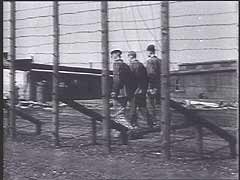
-
Agreement Reached at Munich Conference
Film[This video is silent] An agreement signed at the Munich conference of September 1938 ceded the German-speaking Sudetenland region of Czechoslovakia to Germany. The agreement was reached between Germany, Italy, Britain, and France. Czechoslovakia was not permitted to attend the conference. In March 1939, six months after signing the Munich agreement, Hitler violated the agreement and destroyed the Czech state.

-
Air raid shelter in London during the Blitz
FilmAfter the defeat of France in June 1940, Germany moved to gain air superiority over Great Britain as a prelude to an invasion of Britain. During almost nightly German air raids (known as "the Blitz") on London, the civilian population of the city sought refuge--as shown in this footage--in air raid shelters and in London's subway system (called the "Underground" or the "Tube"). Despite months of air attacks, Germany was not able to destroy Britain's Royal Air Force (RAF). In the fall of 1940, the invasion…

-
Air war in Flanders: Western Campaign
FilmThe Junkers (Ju) 87, known as the "Stuka," spearheaded the Blitzkrieg ("lightning war") attacks that were decisive in the western campaign in 1940. Stuka dive-bombers closely supported German forces on the ground. They destroyed enemy strong points, aircraft, and airfields, and spread panic in rear areas. Although slow and easily shot down by Allied fighters, the Stukas proved devastatingly effective in the German invasions of Poland and western Europe, where Germany enjoyed air superiority. Stuka…

-
Albert Speer makes final statement at trial
FilmDefendant Albert Speer making his closing statement in the Nuremberg courtroom.
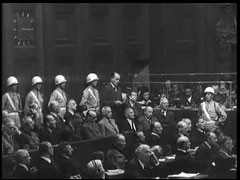
-
Albert Speer sworn in at Nuremberg
FilmDefendant Albert Speer is sworn in at the International Military Tribunal.
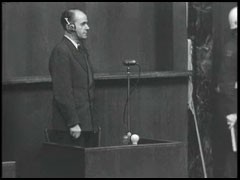
-
Albert Speer testifies at Nuremberg
FilmAlbert Speer gives testimony at the International Military Tribunal. In 1942 Speer was named Minister of Armaments and Munitions, assuming significant responsibility for the German war economy. In this position, Speer used millions of forced laborers to raise economic production.
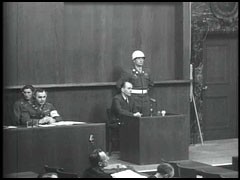
-
Allied prisoner of war describes work details
FilmMost Allied prisoners of war (POWs) were treated well compared to inmates of concentration camps. But, as former Dutch POW Captain Boullard explains here at Dachau concentration camp, some were subject to severe beatings and forced to work in harsh labor assignments.
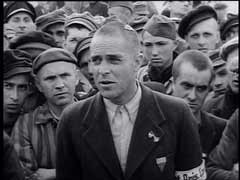
-
Allies evacuate troops from Dunkirk
FilmThe German western campaign in May 1940 decisively defeated the British and French forces arrayed against it. By the end of May, the Allies began the withdrawal of British and French forces from the Continent to prevent their surrender or destruction. The evacuation effort centered on the French coastal town of Dunkirk. As German forces completed their conquest of France, more than 1,000 vessels--including small civilian yachts and fishing boats--ferried Allied forces across the English Channel to Great…
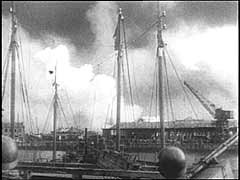
-
Annexation of Austria
FilmGerman troops entered Austria on March 12, 1938. The annexation of Austria to Germany was proclaimed on March 13, 1938. In this German newsreel footage, Austrians express overwhelming enthusiasm for the Nazi takeover of their country.
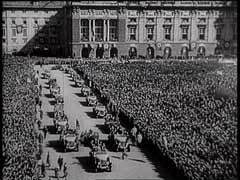
-
Annexation of Austria: The Anschluss
FilmIn an attempt to prevent the German annexation of Austria, Austrian chancellor Kurt von Schuschnigg called a plebiscite (referendum) on Austrian independence. On March 11, 1938, the Germans pressured Schuschnigg to cancel the plebiscite and resign. This German newsreel footage from March and April 1938 served as propaganda for the Nazi annexation of Austria. It begins with images of pro-Nazi residents in Graz expressing their opposition to Schuschnigg's plebiscite. It also includes footage after…
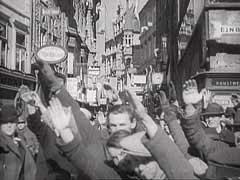
-
Anti-Nazi protest
FilmAdolf Hitler became chancellor of Germany in January 1933. Soon thereafter, terror actions against opponents of Nazism began: Jews were a major target in these campaigns. Many Jews were subjected to public humiliation or arrest, and others were forced to quit their posts. Anti-Jewish measures climaxed with the April 1, 1933, boycott of Jewish-owned businesses. This footage depicts a Jewish anti-Nazi march in Chicago.
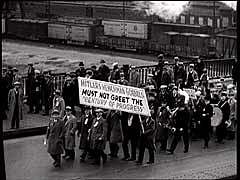
-
Anti-Nazi protest organized by American Jewish Congress
FilmThe American Jewish Congress was among the first groups in the United States to oppose Nazism. It held a mass rally as early as March 1933, soon after Hitler rose to power in Germany, and continued to hold rallies throughout the war years. The American Jewish Congress organized this anti-Nazi march through Lower Manhattan. The event coincided with book burning in Germany.
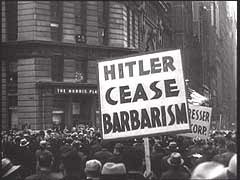
-
Battle for Danzig
FilmThe Treaty of Versailles, imposed on defeated Germany following World War I, declared Danzig to be a free city jointly administered by Poland and the League of Nations. Germany bitterly resented the loss of this largely German city, which was also an important port on the Baltic Sea. The return of Danzig became a central feature of Adolf Hitler's foreign policy. This footage shows pro-German forces besieging a Polish garrison in Danzig's main post office. Germany annexed Danzig after the defeat of Poland…
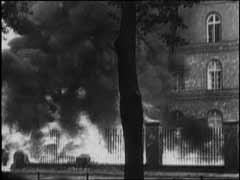
-
Battle of Britain
FilmAfter the defeat of France in June 1940, Germany moved to gain air superiority over Great Britain as a prelude to an invasion of Britain. Despite months of air attacks, Germany was not able to destroy Britain's Royal Air Force (RAF). In the fall of 1940, the invasion was indefinitely postponed. The German bombing campaign against Britain continued until May 1941. The Germans ultimately halted the air attacks primarily because of preparations for the invasion of the Soviet Union in June 1941.
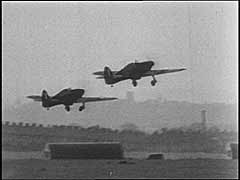
-
Benito Mussolini
FilmBenito Mussolini, leader of the Italian Fascist movement, was prime minister of Italy from 1922 until he was dismissed in July 1943. After the Italian armistice with the Allies in September 1943, German forces occupied northern Italy and installed Mussolini as head of a new pro-German government. In April 1945, as Allied forces advanced into northern Italy, Mussolini attempted to escape to neutral Switzerland. However, Italian partisans caught and executed him before he could reach the border. This footage…
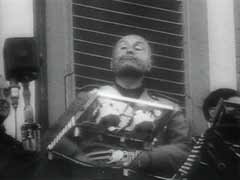
-
Bergen-Belsen after liberation
FilmAs Allied forces approached Germany in late 1944 and early 1945, Bergen-Belsen became a collection camp for tens of thousands of prisoners evacuated from camps near the front. Thousands of these prisoners died due to overcrowding, poor sanitary conditions, and lack of adequate food and shelter. On April 15, 1945, British soldiers entered Bergen-Belsen. They found 60,000 prisoners in the camp, most in a critical condition. This footage shows Allied cameramen filming the condition of the prisoners and the…

-
Berlin-Tokyo-Rome Axis
FilmIn Berlin, Germany, officials from Nazi Germany, Fascist Italy, and Imperial Japan sign the ten-year Tripartite Pact (the Three-Power Agreement), a military alliance. The pact sealed cooperation among the three nations (Axis powers) in waging World War II. This footage comes from "The Nazi Plan," a film produced and used by the United States in the prosecution at the Nuremberg trials.

-
Book peddler in Munkács
FilmExterior of house of study. Book peddler negotiates a sale with a young customer.
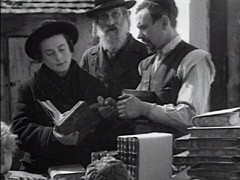
-
Books burn as Goebbels speaks
FilmIn their drive to rid the country of all that they deemed "un-German," the Nazis publically burned books in cities across Germany. Here in front of the Opera House in Berlin, a chanting crowd burns books written by Jews and leftist intellectuals. Joseph Goebbels, Hitler's minister of propaganda and public information, speaks of the intended "reeducation" of Germany.

-
British army chaplain describes Bergen-Belsen upon liberation
FilmBritish troops liberated the Bergen-Belsen concentration camp in Germany in April 1945. They filmed statements from members of their own forces. In this British military footage, British army chaplain T.J. Stretch recounts his impressions of the camp.
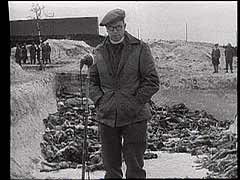
-
British Prosecutor Shawcross
FilmBritish Chief Prosecutor Sir Hartley Shawcross makes a final plea to the International Military Tribunal.
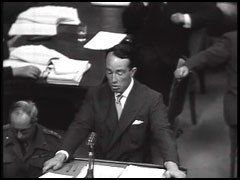
-
British soldiers deport "Exodus 1947" passengers
FilmIn July 1947 in France, 4,500 Jewish refugees from displaced persons camps in Germany boarded the "Exodus 1947" and attempted to sail (without permission to land) to Palestine, which was under British mandate. The British intercepted the ship off the coast and forced it to anchor in Haifa, where British soldiers removed the Jewish refugees. After British authorities failed to force France to accept the refugees, the refugees were returned to DP camps in Germany. The plight of the "Exodus" passengers became…
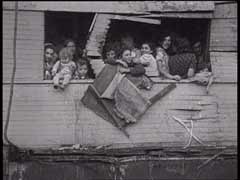
-
Buchenwald concentration camp
FilmClip from George Stevens' "The Nazi Concentration Camps." This German film footage was compiled as evidence and used by the prosecution at the Nuremberg trials.
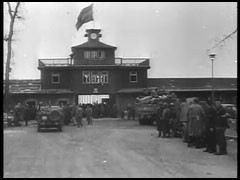
-
Conditions in the Warsaw ghetto
FilmAfter the Germans established the Warsaw ghetto in October 1940, conditions deteriorated rapidly. The Germans strictly controlled the movement of goods into and out of the ghetto. There was not enough food to feed the ghetto residents. At great personal risk, many Jews attempted to smuggle in food. The German food ration for Warsaw ghetto inhabitants amounted to less than 10 percent of the ration for a German citizen. Thousands of Jew died in Warsaw each month because of starvation or disease.
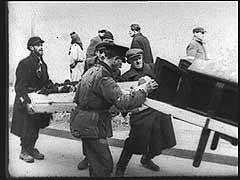
-
Conditions in the Warsaw ghetto
FilmThe Nazis sealed the Warsaw ghetto in mid-November 1940. German-induced overcrowding and food shortages led to an extremely high mortality rate in the ghetto. Almost 30 percent of the population of Warsaw was packed into 2.4 percent of the city's area. The Germans set a food ration for Jews at just 181 calories a day. By August 1941, more than 5,000 people a month succumbed to starvation and disease.
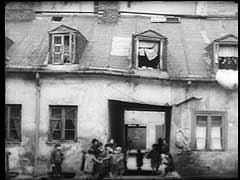
-
Conditions in the Warsaw ghetto
FilmThe Nazis sealed the Warsaw ghetto in mid-November 1940. German-induced overcrowding and food shortages led to an extremely high mortality rate in the ghetto. Almost 30 percent of the population of Warsaw was packed into 2.4 percent of the city's area. The Germans set a food ration for Jews at just 181 calories a day. By August 1941, more than 5,000 people a month succumbed to starvation and disease.
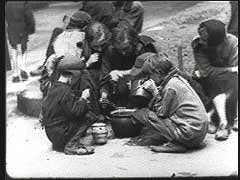
-
Croatian fascist leader Ante Pavelic
FilmAnte Pavelic was a Croatian fascist leader who headed a pro-German government in Croatia from 1941 until 1945. This captured German newsreel shows Pavelic walking through an adoring crowd and reviewing his units. Under Pavelic's rule, the Croatian government killed hundreds of thousands of Serbs, Jews, and Roma (Gypsies). Pavelic fled to Argentina after the war. He died in 1959 from wounds he received in an assassination attempt two years earlier.
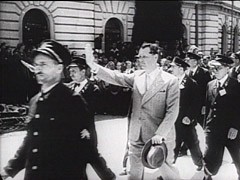
-
Cross examination of defendant Walter Funk
FilmUS prosecutor Thomas Dodd cross examines defandant Walter Funk, former president of the German national bank. Dodd questions Funk about the possessions confiscated from concentration camp prisoners and elsewhere in German-occupied territories.

-
Dachau after liberation
FilmThe Dachau concentration camp, northwest of Munich, Germany, was the first regular concentration camp the Nazis established in 1933. About twelve years later, on April 29, 1945, US armed forces liberated the camp. There were about 30,000 starving prisoners in the camp at that time. The film seen here was edited from original footage shot by Allied cameramen as liberating troops entered Dachau. It was discovered in the archives of the Imperial War Museum in 1984 and was never completed.
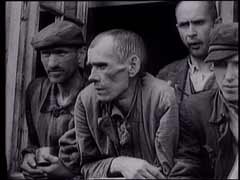
-
Daily life in the Warsaw ghetto
FilmA bridge connected areas of the Warsaw ghetto to prevent Jews from entering the streets that were not part of the ghetto. Before the ghetto was sealed, the few entrances and exits had checkpoints. In the early months of the ghetto, life had the appearance of normalcy, but very soon the lack of food and adequate housing began to take its toll.
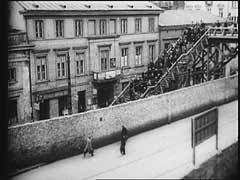
-
D-Day
FilmMassive Allied landings of air- and sea-borne forces on five Normandy beaches (codenamed Utah, Omaha, Gold, Juno, and Sword) began on June 6, 1944 (D-Day). The purpose of the invasion was to establish a bridgehead from which Allied forces could break out and liberate France. By the end of the operation's first day, some 150,000 troops were ashore in Normandy. This footage shows Allied forces landing on the Normandy beaches.
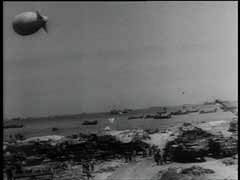
-
D-Day bombings over France
FilmAllied air superiority over Germany was a decisive factor in the success of the D-Day (June 6, 1944) landings in France. This footage shows the Allied bombing of suspected German positions during the battle. Allied air attacks both supported Allied ground operations in Normandy and prevented German reinforcements from reaching the area. The Allies would liberate most of France by the end of August 1944.

-
Defeat of Belgium
FilmGerman forces invaded western Europe in May 1940. As part of their strategy to defeat Britain and France, German forces invaded neutral Belgium. Little more than two weeks after the German invasion of Belgium, King Leopold III ordered the surrender of the Belgian army. In this footage a Belgian officer signs the surrender and thousands of refugees flood the streets as German forces move through Belgium.

-
Defendant Hans Frank testifies
FilmDefendant Hans Frank gives testimony to his defense lawyer during the Nuremberg trial about his leadership roles during the Third Reich.
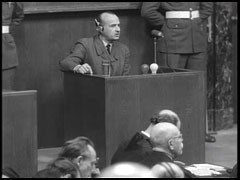
-
Defendant Hermann Göring listens to trial testimony
FilmDefendant Hermann Göring, seated at left in the dock, listens as US Chief Prosecutor Robert Jackson interrogates witness Albert Kesselring about the Luftwaffe (German Air Force).
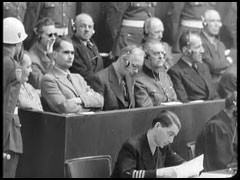
-
Defendant Julius Streicher
FilmDefendant Julius Streicher is sworn in as a witness during the International Military Tribunal at Nuremberg.
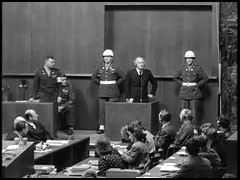
-
Defendants enter pleas at Nuremberg Trial
FilmAfter the defeat of Germany, the Allies tried leading state and party officials and military commanders of the Third Reich before a tribunal of military judges from the Soviet Union, Great Britain, France, and the United States. This International Military Tribunal tried 22 major war criminals during what is commonly known as the Nuremberg Trial, which lasted from November 1945 to October 1946. This footage shows the accused entering pleas following their indictment on charges of crimes against peace, war…

-
Defendants in the dock
FilmThe International Military Tribunal defendants in the dock at Nuremberg.
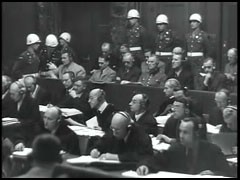
-
Deportation of Jews from Balti, Bessarabia
FilmThe Romanian government was allied with Nazi Germany, but it generally did not deport Romanian Jews to German-occupied territory. Instead, Romania systematically concentrated and deported the Jews of Bessarabia and northern Bukovina to Romanian-occupied areas of the Ukraine. Here, Jews from the Bessarabian town of Balti are assembled in collection camps during the deportations. By the end of May 1942, Romanian security forces had killed or deported most of the Jews in the area. Only about 200 Jews remained…
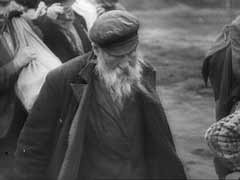
-
Deportation of Jews from Bulgarian-occupied Thrace
FilmJews were deported from Kavala, Seres, and Drama in Bulgarian-occupied Thrace. Some 3,000 Jews were taken to Drama and herded onto trains without food or water for transport to a camp in Gorna Dzumaya. The Jews were probably then taken to the Bulgarian port of Lom on the Danube River, where they boarded ships for Vienna. From there, the Nazis deported them to the Treblinka killing center.
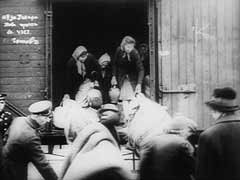
-
Destruction of Lidice
FilmCzech resistance fighters attacked Reinhard Heydrich, acting governor of the Protectorate of Bohemia and Moravia, in an ambush near Prague in May 1942. Heydrich died of his wounds on June 4, 1942. In retaliation for the attack, the Germans destroyed the village of Lidice on June 10, 1942. The Germans shot all the men in the village and deported most of the women and children to camps in Germany. This footage shows destroyed homes and German officials inspecting the remains of the village.
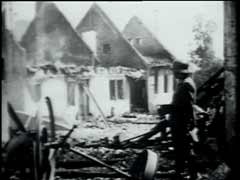
-
Displaced persons camp in Austria
FilmAfter World War II, the Allies repatriated millions of displaced persons (DPs) back to their countries of origin. But hundreds of thousands of people, including more than 250,000 Jewish refugees, could not or would not return. Most Jewish DPs preferred to leave Europe for either Palestine or the United States. The United Nations Relief and Rehabilitation Administration (UNRRA) housed them in camps in occupied Germany and Austria until they could be resettled. Here, Jewish DPs raise their children in the…
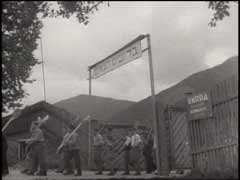
-
Displaced persons leave for the United States
FilmAt the end of World War II, the Allied powers in Europe repatriated from Germany millions of displaced persons (DPs). The remaining 1.5 to 2 million DPs—both Jews and non-Jews—refused or were unable to return to their prewar homes. Immigration restrictions precluded the large-scale admission of these refugees to other European countries and the United States. They remained in occupied Germany until they could arrange to settle in another country. In this footage, filmed more than four years…
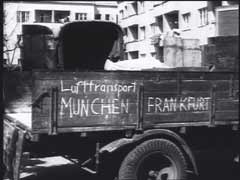
-
Einsatzgruppen in Liepaja, Latvia
FilmGerman Einsatzgruppen operated in German-occupied territories in eastern Europe during World War II. This rare footage shows a unit during a massacre in Liepaja, Latvia. The film was taken, contrary to orders, by a German soldier. Before the war, the Jewish population of Liepaja stood at more than 7,000 residents. Einsatzgruppen shot almost the entire Jewish population of the town. When the Soviet army liberated the city in 1945, just 20 to 30 Jews remained. Einsatzgruppen carried out various security…
